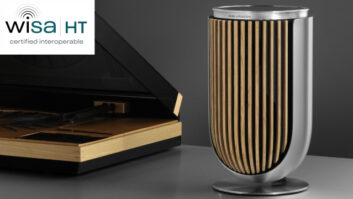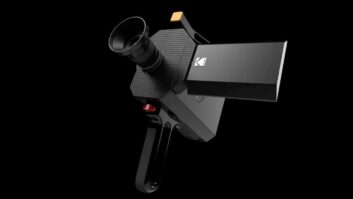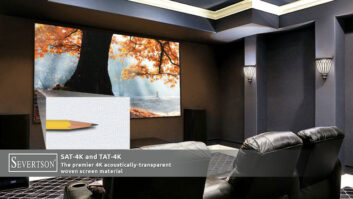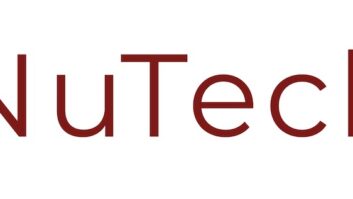Berlin – This year’s IFA exhibition here is turning into a Windows 8 coming-out party, escorted by previews of TV’s 4K and OLED future.
Samsung, Sony, Dell and Lenovo were among the companies to debut Windows 8 phones, tablets, laptops and, surprisingly, laptop/tablet convertibles — which seemed to have died off in the wake of the iPad. Many of the new Windows 8 devices offered 10-point multipoint multi-touch interfaces, and included some surprisingly large screens.
In addition, both Samsung and LG once again displayed competing 55-inch LED HDTVs, but with designs updated since their initial splash at International CES earlier this year — although U.S. availability remains an unannounced mystery. And LG, along with Sharp and Sony, unveiled 84-inch 4K HDTVs with unknown U.S. arrival dates or prices.
Since there is not — and is unlikely to be — any 4K broadcast content, most 4K sets will automatically up-convert all lower-resolution material.
Not all the news from Berlin was big, bright and touchable. After several years of strong growth in both exhibitors and attendees, organizers reported the former dropped by two to 1,439 from last year’s record number. IFA the show officially opens Friday/tomorrow so no attendance figures are available yet, but attendance is expected to hover around the 240,000 mark, similar to last year.
IFA’s stalled growth is obviously attributed to the European economy. While sales of all manner of TVs (smart, 3D, large screen), tablets and smartphones are expected to rise by the end of the year, market research firm GfK reported sales of CE products in Europe’s biggest markets (Germany, France, Italy, The Netherlands, Spain and the U.K.) dropped 10 percent compared with the first six months of 2011.
For instance, despite the European Football (soccer) championships, Old World consumers spent 9 percent less from January through June 2012 on TVs than during the same period last year. Only Germany saw an overall uptick in TV sales in the first half of this year, a plus 8.5 percent.
Nearly every other CE category suffered sales losses in the first half of this year. Blu-ray and DVD hardware sales plummeted in Spain and Italy by around 30 percent; Germany’s disc player/recorder sales were “just” 8 percent off. Hi-fi and home-theater product sales fell 3.6 percent, portable audio device sales deteriorated by 17 percent thanks to the growing popularity of smartphones, car radios sales were off by 22 percent, digital cameras sales declined by 7 percent and IT products suffered a 7.3 drop.
Not surprisingly, sales of speaker docks and headphones are both up.
What might rescue the computing market in Europe and everywhere else is Windows 8, at least judging by the initial announcements at IFA the last two days, while new 4K and OLED displays are garnering a lot of attention. For instance:
Dell: Three new and unusual 10-point multi-touch touchscreen Windows 8 products will be coming from the Texas-based computer maker — the all-in-one XPS One 27, the convertible XPS Duo 12 12.5-inch laptop, and the XPS 10 tablet/detachable keyboard.
Sharing similar design as the Dell’s Inspiron line, the XPS One 27 has a dual-hinged stand/arm supporting the 27-inch screen. Merely pushing the screen creates any number of unusual angles, including flat.
Copying an earlier Dell netbook design, the 12.5-inch screen on the XPS Duo 12 screen swings 360 degrees inside the machined aluminum bezel to lie flat against the QWERTY and create a thick tablet.
The 10.1-inch screen on the XPS 10 pops right off the keyboard; when attached, it looks and acts just like a standard clamshell laptop. As a tablet, the XPS 10 runs Windows 8 RT and will run for a claimed 20 hours on its battery.
All three will be available after Microsoft officially introduces Windows 8 and, presumably, its own tablets.
LG: Unlike its 4K and OLED competitors, LG announced less vague availability and pricing for its two future TV products — for Korea. Its 0.16-inch-thin, 55-inch passive 3D OLED will go on sale in the company’s home country later this year for $10,000.
LG’s 84-inch ultra-definition 4K (3,840 by 2,160) 3D LED HDTV, which comes with a Magic Remote with a floating cursor for easier app access, is due to go on sale this month in outh Korea for 16,500 euro, “followed by key markets in Europe, the Americas and Asia in the months to come,” according to the company.
Samsung: Like its Korean competitor, Samsung festooned its large IFA booth with a multiscreen OLED exhibit. Like LG, Samsung’s pencil-thin ES9500 OLED model measures 55 inches. Unlike LG, Samsung still provided no retail arrival or pricing information.
However, its newly designed OLED includes a pop-up camera/mic array to enable voice and gesture control, and dual multi-view capabilities. Two viewers wearing active 3D glasses each will see different images, and Samsung’s 3D glasses will include built-in earphones so each viewer only hears what s/he is watching. In addition, the usual rear cable mess is controlled through sleek, silver stands.
Sharp: Instead of traditional LED LCD technology, Sharp is pursuing its own Integrated Cognitive Creation (ICC) 4K LED path.
The company displayed a prototype at last year’s IFA as well as this year’s CES, but has made improvements for this year’s 60-inch demo set. ICC “plays with light” via sophisticated software algorithms to manipulate the brain’s perception of the image and create 3D-like effects.
Executives noted the ICC set would be available sometime next year; judging by the status of the prototype that probably means later rather than sooner.
Sony: Both of Sony’s pending Windows 8 entries also veer from the conventional.
For instance, the Tap 20 is a portable 10-point multitouch 20-inch flat-screen all-in-one PC designed to be carried and placed anywhere around the house. Its built-in stand is completely angle adjustable, including laying flat. One demo was of an impressive air hockey simulation game played across the flat Tap screen. Tap will run on either AC or battery.
Sony also demonstrated its own Windows 8 Duo laptop/tablet convertible, the Vaio Duo 11. Instead of its 11.6-inch screen swinging similarly in the bezel ala Dell’s Duo, Sony’s screen slides flat on top of the attached keyboard, and includes a digitizer writing stylus. At 2.86 pounds, the Duo 11 weighs about as much as an Ultrabook, with which it will presumably compete.
In addition to its 84-inch 4K Bravia, Xperia tablet and two Windows 8 entries, Sony also announced three new Xperia smartphones due next month.
The global flagship Xperia T sports a 4.6-inch screen capable of displaying 1080p video. It also has a sleep-to-snap quick wake-up function for instant photo shooting and can be quickly woken up to snap a photo, and is imbued with NFC designed to tap-and-pair the phone via Bluetooth to a number of upcoming Sony NFC accessories such as speakers and headphones.
To boost the Xperia T’s street cred, the smartphone will be wielded by Daniel Craig in the upcoming James Bond film, “Skyfall.”
The other two Xperia phones are the splash-proof Xperia V and the entry-level Xperia J, which will supplement the company’s current P, S and U Xperia smartphone models.













